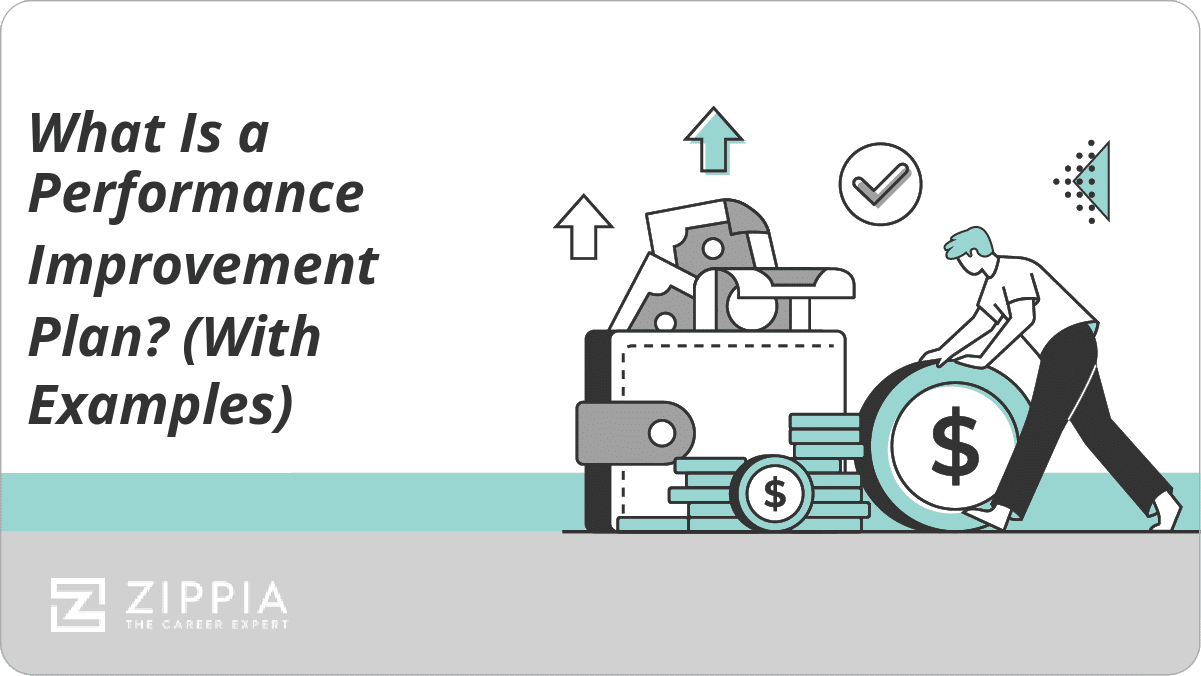- Mentoring
- What Is A Mentor
- Mentor Traits
- Talent Management
- Performance Improvement Plan
- Performance Review Phrases
- Four Functions Of Management
- Difference Between Goals And Objectives
- How To Give Employees Feedback
- What Is An Operational Environment
- Key Success Factors
- How To Not Get Fired
- How To Be More Confident At Work
- One-On-One Meeting
- Performance Management
- Professional Development
- The Peter Principle
- Positive Feedback
- Low Hanging Fruit
- Upskill Your Employees
- Motivation Letter
- Personal Goals
- Networking
- Quotes
Find a Job You Really Want In
If you hear that you’re going on a Performance Improvement Plan, or a PIP, you might get a little nervous. Some people even refer to it as the document before you get fired. Can you save your job after you’ve been told you’re going on a performance improvement plan?
Maybe. It depends on how your boss or human resources department thinks of a PIP. Let’s get a clearer picture of what an employee performance improvement plan really is.
Key Takeaways:
-
While a PIP generally means that something about your work needs to improve, it isn’t the end of the world and can actually be an opportunity to improve.
-
A PIP should have clear, well-defined steps so that everyone involved is on the same page, and should be documented thoroughly.
-
Ultimately, going on a PIP can be an opportunity to improve and get back on track, or it may be a signal that you might want to consider whether your current position is right for you.

What a Performance Improvement Plan Is, Explained
In most situations, but not all (we’ll get into that also), a performance improvement plan means that there is an area of your work performance that needs improving. That’s pretty obvious, right? The plan is a step by step process of how you can improve your job competencies.
-
Does a PIP mean I’m getting fired? Not necessarily, but there’s a good chance that you’re headed in that direction. Most human resources companies know that they need to keep a good paper trail of concerns when they’re considering firing someone.
This isn’t always the case, but it is good management to do this. It can help them avoid lawsuits in the future, or at least win them. A PIP often serves as one of these backup documents.
A careful review of your PIP can give you a bit more insight into what your future with the company will be or not be. If it’s doable, specific, measurable, and the language is positive – then you’re in a good spot. If the PIP is vague, seems impossible, and the language doesn’t really talk about you moving out of the PIP – it’s time to start looking for a new job.
-
Can a PIP be a good thing? Yes! Believe it or not, a PIP can be very positive. It can mean that the company doesn’t want to lose you; they just want improvement. It’s not synonymous with a probationary period like many people think it is.
Think of a PIP as a structured way to improve job performance based on constructive criticism. In fact, you may actually like being on a performance improvement plan. If you’ve been thrown into a task that you weren’t properly trained for or there’s a new procedure, a PIP helps you learn the ropes and feel more confident about your ability.
-
What about companies that use PIPs regularly? This is the situation we said we’d discuss at the outset. Some companies like to use these plans regularly to keep people on task and slowly bring up the entire organization’s performance.
However, if this is the case, they usually call them something else. Including the word “improvement” in the title suggests you’re not quite doing what they want.
How to Handle a PIP
In theory, a PIP could be implemented at any point that it seems like an employee is having trouble or falling behind. It’s often the case that supervisors don’t really look at individual performance unless there is a big problem or it’s time for a performance review. This means that most PIPs are a part of performance goals and employee development, but this doesn’t have to be the case.
If you’re told that you’re going on a PIP, don’t panic. Instead, do your best to:
-
Respond calmly, and keep a positive attitude
-
Ask for any necessary clarification about the process and expectations
-
Determine what steps you personally need to take to improve your performance
-
Check in regularly with management and HR and keep communication open
-
Don’t be afraid to ask for help if you need it
Performance Improvement Plan Process
Now that your employer is ready to implement a PIP, these are the steps they have to take:
-
Definition. Clearly state the performance that needs to be improved with examples and details.
-
Expectations. Explain what is expected of the employee or of that task. Detail how it should be done and how frequently. I.e., meeting a goal once is not good enough, and missing a management goal once typically doesn’t mean you’ll be fired. There are obviously situations where this isn’t true, but that is why it needs to be spelled out in detail in the PIP.
-
Process. Detail how the employee is expected to make their improvements. Will they be trained or mentored by someone? Is there a step-by-step process that they will be following? This should be almost like a checklist that the employee and management can return to for reference.
-
Feedback. Now that the employee knows the steps, there needs to be feedback. Being told how to do something is one thing, but it can fall apart if constant feedback, negative and positive, isn’t provided.
Schedule times for meetings, demonstration times, nightly or weekly email check-ins – whatever works best for your job. By the way, this step is not just for the employee to get feedback. They can also give feedback about how they feel about the process. This information can help a PIP be successful.
-
Consequences. The next part can be tricky because it deals with the consequences of the feedback. If the feedback is positive, it’s not such a sticky situation; the employee has succeeded and keeps their job. If the feedback is negative or the employee fails to keep up their end of the PIP, then a demotion, probationary period, or even the loss of a job can result.
-
Next steps. Whether the employee is successful or has failed, they need to know what their outcome will be. Typically, the next steps involve a final meeting with a supervisor or HR. Whether they’re going to lose their job or keep it, the employee needs to know how it will be handled and what to expect.
Performance Improvement Plan Form
Company name:
Employee name:
Job Title/Position:
Department:
Supervisor:
Date:
Performance in need of improvement: (Remember that this needs to be very detailed with examples of how it has been going and how it should go.)
Expectation of results from PIP: (Detail what is expected from all employees who perform this role successfully. Make sure there are no questions about what is “good enough.” They should also understand the timeframe involved.)
Process for improvement: (How will the employee go from where they are to where you want them to be. What resources will they be given, who will help them, what are the steps to success?)
Feedback: (Include dates of check-ins here. If possible, select dates for feedback so it’s not a surprise. Explain how feedback will be given – it’s a good idea to keep a written record. This could be a very long section if you want to add feedback each time it’s given, or that could end up being a supplemental document.)
Consequences: (What happens if each step isn’t successfully completed, and what if it is? How much time is involved with each step?)
Next Steps: (Both success and failure next steps and any possible intermediary next steps need to be spelled out. You may not want to include all of the next steps here if they’re detailed in an employee handbook. In this case, you can simply refer to that.)
Summary: A brief summary of the PIP, what happened during it, and the final results should give anyone an “at a glance” idea of the situation.
Employee Signature:
Date:
Supervisor Signature:
Date:
Human Resources Signature:
Date:
PIP Tips for an Employer or Manager
Even if you have the best intentions and want to keep your employee, they will have some feelings that you need to be mindful of. Most likely, they’re going to feel like they’re being reprimanded, and that’s not a good feeling.
You may encounter a rare employee who is thankful that they’re getting some help. There might also be that apathetic employee who doesn’t care. No matter which feelings they have, it’s best to show your support in a professional manner.
Being as detailed and thorough as possible in the PIP will work to your benefit in the long run. While a verbal discussion might seem totally clear and understood by all parties, they’re impossible to prove and fade from the memory over time. Written details last and hold up if there’s ever a lawsuit or grievance.
Being discreet is also a pretty important part of a PIP in most situations. Unless your company uses them for everyone or regularly, you don’t want to share this information. It can make your employee feel ostracized and like you’re picking on them. This is never good in a work setting.
Include HR in all communications where possible. They will need to know about the PIP and have some input. It might also be a good idea to keep them apprised of feedback and check-ins. This is especially true if your company uses a PIP as the first step in the firing process.
Final Thoughts
A PIP is your chance to improve, and you’ve been given the steps and resources you need to do that. Or, on the other hand, this is your chance to realize that your job might not be the right fit for you.
Take this time to work on your career skills with your employer. Let them know you’re willing to improve, and welcome their help. And if you decide that this is not the job or not the company for you, you’ve got a little time to start figuring out what your ideal job might be.
- Mentoring
- What Is A Mentor
- Mentor Traits
- Talent Management
- Performance Improvement Plan
- Performance Review Phrases
- Four Functions Of Management
- Difference Between Goals And Objectives
- How To Give Employees Feedback
- What Is An Operational Environment
- Key Success Factors
- How To Not Get Fired
- How To Be More Confident At Work
- One-On-One Meeting
- Performance Management
- Professional Development
- The Peter Principle
- Positive Feedback
- Low Hanging Fruit
- Upskill Your Employees
- Motivation Letter
- Personal Goals
- Networking
- Quotes





